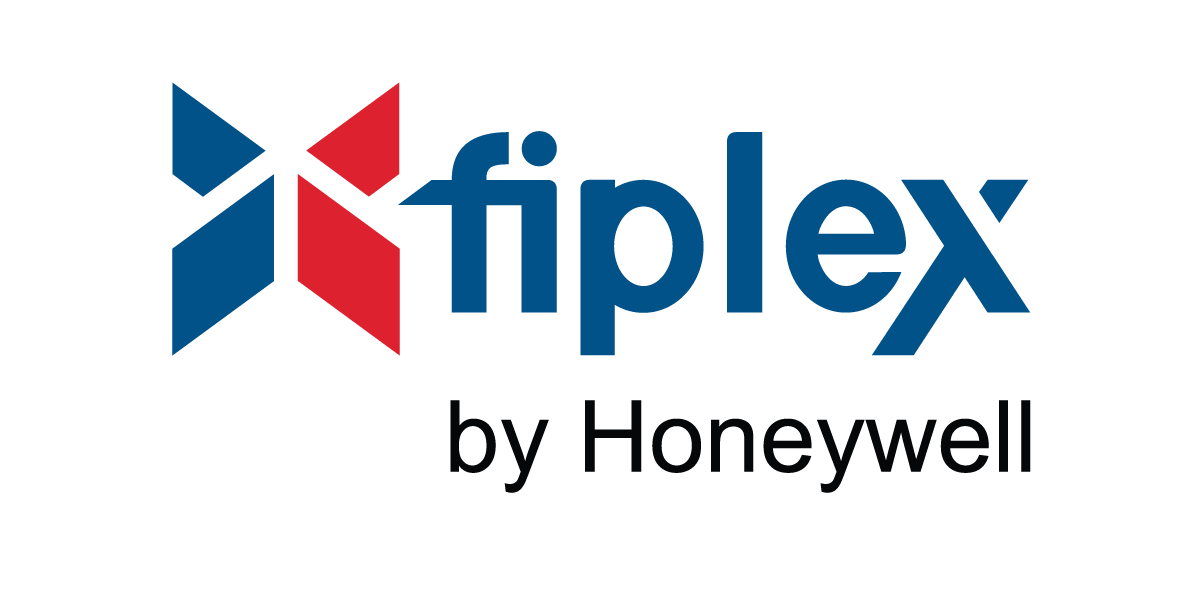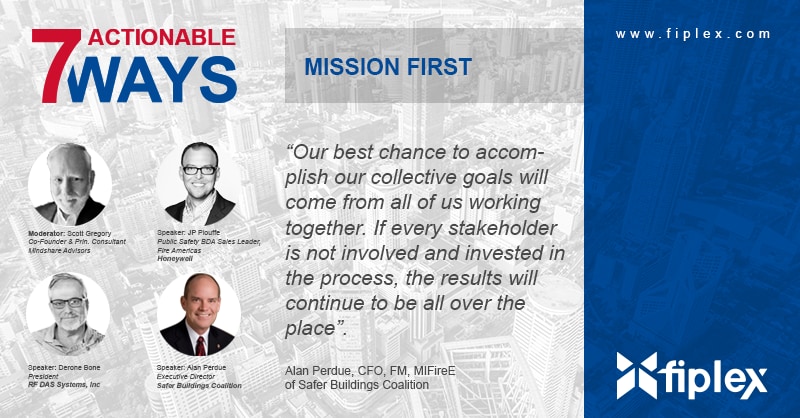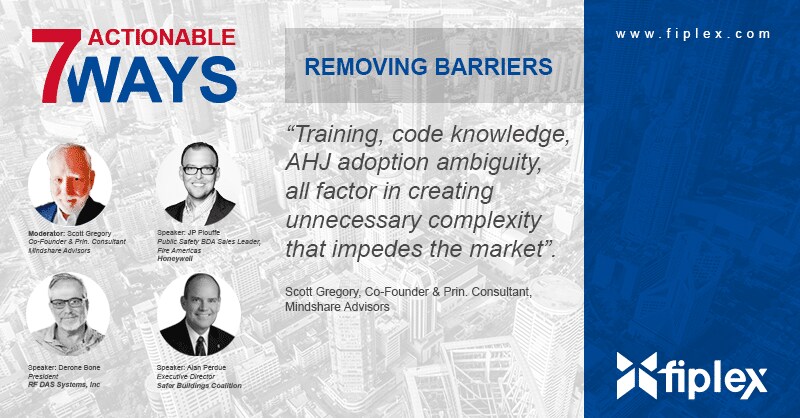There is little argument that more buildings need to be assessed, upgraded and or otherwise certified that first responder’s communications, are not impeded in the event of an emergency yet, seemingly at every turn there are barriers that hold back full-scale code adoption, and solution deployment form happening. A recent series of social media posts highlighted these challenges and a recent panel at IWCE 2021 explored these challenges further, creating a list of “ 7 actions” that the industry at large needs to take … Follow these posts to discover their findings.
Things are developing fast for the in-building life safety communications industry: Technology, Code Adoption, New Integrators … we are all working to overcome challenges, but all stakeholders need to never forget the Mission: Keeping critical RF communications available and working when and where it is needed most. This Mission First action actually came at the end of the panel’s session, and yet is really the true north of our efforts.
Mission First is at the heart of our industry’s culture. This means that Technology, Code, Education, and Training, while very important, should not create barriers, but rather accelerate and scale the Mission’s outcomes. Referring to the Mission as a collective goal, Alan Perdue, CFO, FM, MIFireE of Safer Buildings Coalition puts it into perspective this way: “Our best chance to accomplish our collective goals will come from all of us working together. If every stakeholder is not involved and invested in the process, the results will continue to be all over the place.
The panel agreed that the Mission First mindset starts with each of us and needs to be harmonized across the industry. Are you Mission First Focused?
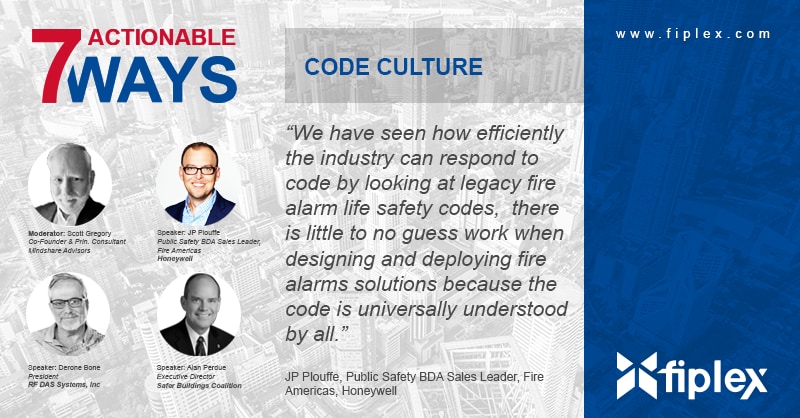
Interpretation, Adoption, Enforcement of ERRCs Public Safety Codes are addressed slightly differently depending on the jurisdiction. While we all welcome the industry progress, these slight differences do create hurdles that will slow down said progress. Having to translate each AHJ’s expectation and identify the proper solution can get complicated and is a drag on the mission. “Harmonizing the AHJs expectation, across all the industry’s stakeholders, reduces complexity and will accelerate and scale the mission,” indicated panelist JP Plouffe of Honeywell, offering further insight, “ we have seen how efficiently the industry can respond to code by looking at legacy fire alarm life safety codes, there is little to no guesswork when designing and deploying fire alarms solutions because the code is universally understood by all.”
Today, vague fire rating or survivability interpretation can make some ERRCs projects near impossible to deploy however, with increased uniformity in training and universally accepted interpretation, the industry will develop action number two. A “Harmonized Code Culture” that quickly addresses uniform interpretation of code and AHJ expectations.
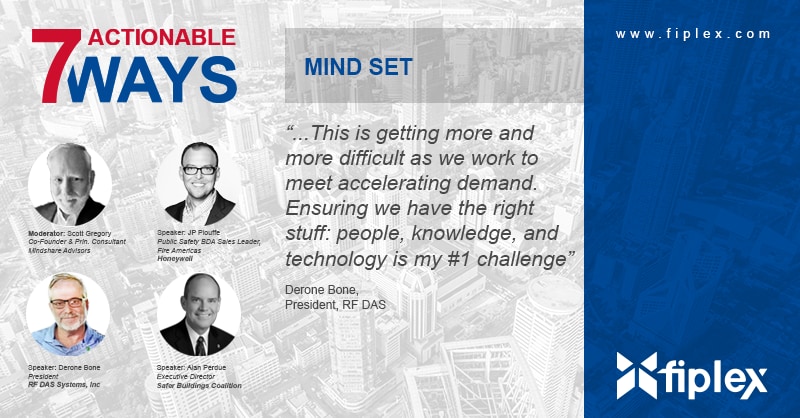
Ask any in-building public safety integrator “ … what are the top 3 challenges on a typical install ?”, and you may just get 300! This strikes at the heart of the industry’s challenge. More buildings need to be validated or properly equipped to ensure first responder communications with the success of an installation being the responsibility of the integrator. Deron Bone of RF DAS systems gets it! Deron has a track record that must be the envy of the industry stating, “we complete hundreds of projects a year and never fail to pass a final … in this business it is critically important to understand every aspect of code, the RF environment you’re dealing with and the technology you’re deploying. This is getting more and more difficult as we work to meet accelerating demand. Ensuring we have the right stuff: people, knowledge, and technology is my #1 challenge! ”
With the market demand increasing at a rate that outpacing the growth rate of new RF integrators, it is more important than to attract new integrators into the market and to do so by creating a proper pathway into the market. This includes our first two identified actions and creating a robust industry-wide, harmonized training effort. More on that training and education next.
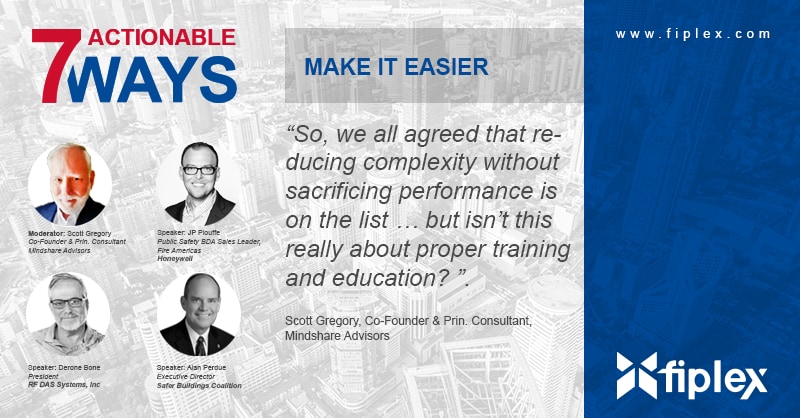
It was unanimous, “make it easier” whether your dealing RF challenges, infrastructure or interpretation of code there is the need to harmonize and simplify. The panel was a bit split on the requirements. “So, we all agreed that reducing complexity without sacrificing performance is on the list … “ said panel moderator Scott Gregory, “ but isn’t this really about proper training and education? ”. This prompted a deeper conversation that explored the growing innovation around software-based systems, leveraging the cloud, automation and even AI.
Training is important but bringing ERRCs systems into the current stream of technology is the key to scaling and advancing deployments. For example, mitigating uplink noise today is often viewed as a training issue. Yes, system designers and installers need to understand the cause and impact, however, if the BDA or DAS system can monitor, detect and “tune” to prevent the noise scenario, all stakeholders would benefit. Intelligent systems combined with training and education is action # 4.
Reducing complexity has another positive impact on the market too. Next up, removing barriers to grow the market.
2 million, 5 million, 10million… the exact number of buildings and venues that need to be surveyed and most likely upgraded with an ERRC solution is big and the bottom-line is that the industry needs to grow in both the number of integrators and in expertise and competency for all stakeholders.
The panel agreed that the success of the mission is predicated on removing barriers that prevent new integrators and technicians from quickly entering the market and AHJs from implementing adoption strategies.
“Knowledge transfer is the barrier! Every stakeholder in the market will require training at some level and it would be nice if the content was all the same.” said panel moderator Scott Gregory of Mindshare Advisors.
“Training, code knowledge, AHJ adoption ambiguity, all factor in creating unnecessary complexity that impedes the market.”
The panel universally agrees that the answer to removing barriers is also a barrier! For example, onboarding and training installers and RF designers is time-consuming and expensive and one of the biggest entry hurdles for a new integrator, but the answer, access better training options, is also a barrier.
It is clear that the path to success is gated by efforts to standardizing (or harmonizing from earlier actions ) training curriculum and scaling the availability and access to nationally recognized certification. NICET is taking step in the right direction and is currently offering training and certification. What barrier can you help remove…
